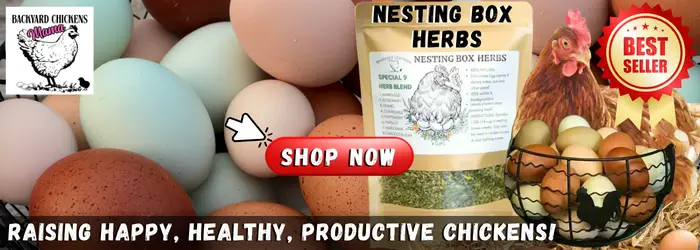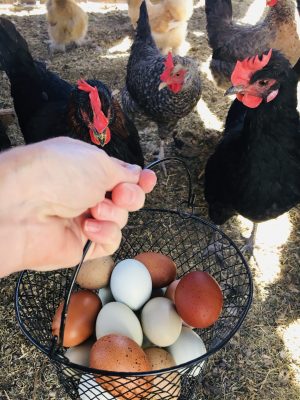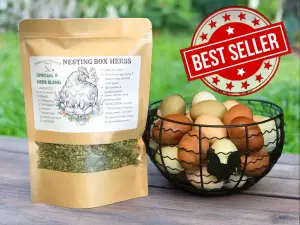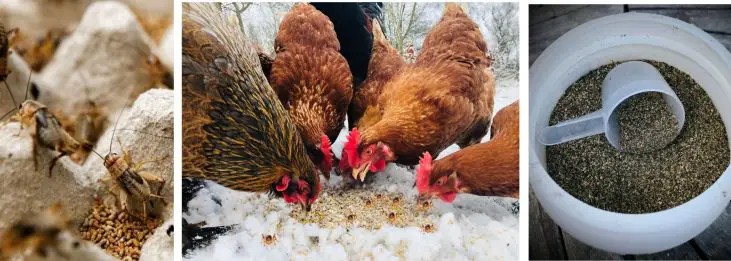
For those of you that own a pet that eats crickets, you know how expensive buying them at your local pet store is. Instead, why not breed crickets at home? Breeding crickets at home is a great way to save you quite a bit of money and also be able to offer your pet increased protein and other important nutrients their body craves.
Breeding crickets at home is really quite simple to do, doesn’t take very many supplies and puts you in control of what you are feeding your pet chicken, duck, gecko or other reptile.
This article will walk you through the steps so you can breed your own cricket farm at home and give you helpful tips to make it much easier for you to do.
- Life Cycle of a Cricket
- Step 1: Cricket Breeding Supplies
- Step 2: Cricket Breeding Setup
- Step 3: Caring for Crickets
- Step 4: Crickets Laying Eggs
- Step 5: How to Incubate Cricket Eggs
- Step 6: Cricket Eggs Hatching
- Step 7: Caring for Pinhead Crickets
- Step 8: Feeding Chickens Crickets
- Step 9: Using Cricket Frass in the Garden
- How to Use Frass in Your Garden
- Conclusion: How to Breed Crickets at Home
Life Cycle of a Cricket
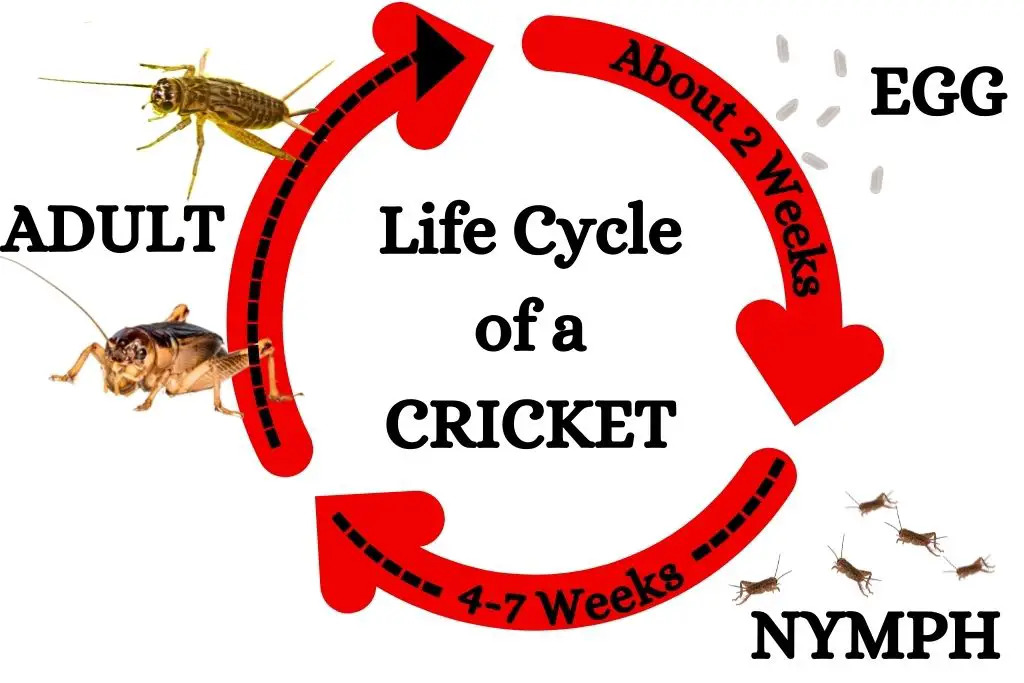
There are a total of three life stages of a cricket; egg, nymph and adult. The average life cycle of a cricket lasts 2-3 months, but this can vary depending upon the temperature and humidity.
Crickets will reproduce in warm temperatures with high humidity. They prefer a temperature around 86℉.
If the temperature drops down to around 59℉, crickets will begin to hibernate.
The cooler the temperatures, the longer it will take for a cricket to complete a life cycle.
Step 1: Cricket Breeding Supplies
| ITEM | USE |
|---|---|
| CRICKETS | BREEDING |
| TWO, 14 GALLON TUBS WITH LIDS | (1) CRICKET BREEDING CONTAINER, (1) INCUBATOR |
| SCREEN | TO COVER BREEDING TRAYS & VENTILATION ON LID OF BREEDING TUB |
| EMPTY LUNCH MEAT CONTAINERS | BREEDING TRAYS TO PUT SUBSTRATE IN FOR EGG LAYING |
| POTTING SOIL | CRICKET EGG LAYING SUBSTRATE |
| SPRAY BOTTLE | TO KEEP SUBSTRATE MOIST |
| FOOD: POTATO, APPLE, ORANGE SLICES, CHICKEN CRUMBLES, LETTUCE | ADD FOOD BREEDING CRICKETS |
| PAPER TOWEL | KEEP MOIST WITH WATER FOR HYDRATION |
| EMPTY EGG CARTONS OR TP ROLLS | FOR CRICKETS TO HIDE |
| HEAT SOURCE | TO MAINTAIN 70°-75℉ FOR BREEDING CRICKETS AND 90℉ FOR INCUBATING EGGS |
Where to Buy Breeding Crickets
Most pet stores carry small (pinhead), medium and large crickets. They can also be purchased from online breeders. Online breeders have a wide variety of sizes available and you can even buy them in bulk for a lower price than you can get from your local pet store.
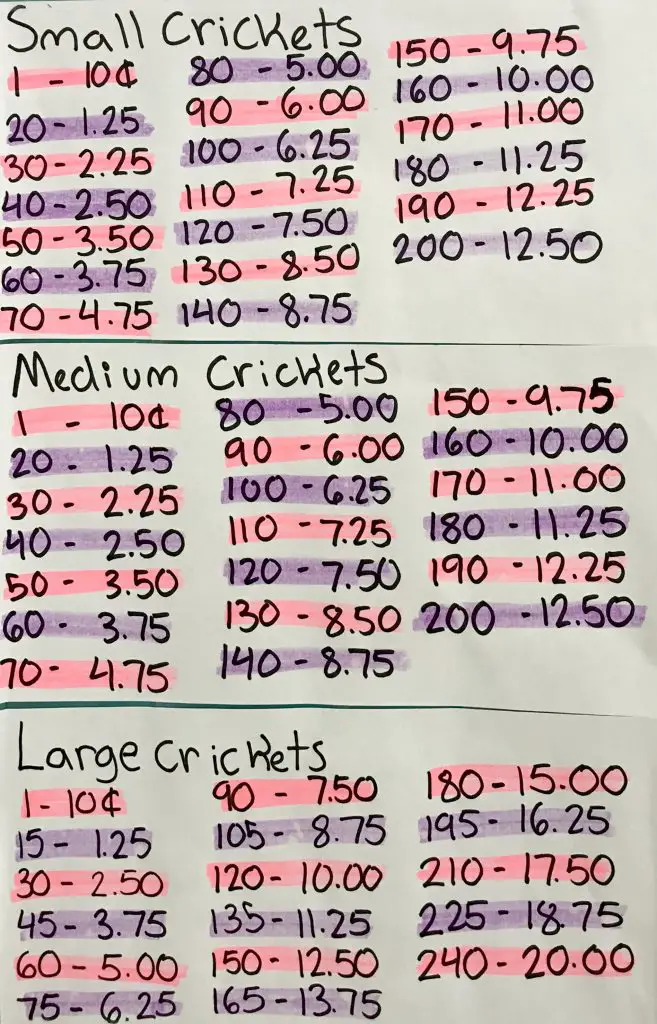
Pro Tip 1: Prices range from .10-.12¢ per cricket at your local pet store. If you purchase crickets online in bulk, you can get them for as low as .02¢ each.
| CRICKET SIZES AVAILABLE |
|---|
| 1/16″(pinhead) |
| 1/8″ |
| 1/4″ |
| 3/8″ |
| 1/2″ |
| 5/8″ |
| 3/4″ |
| ADULT |
Step 2: Cricket Breeding Setup
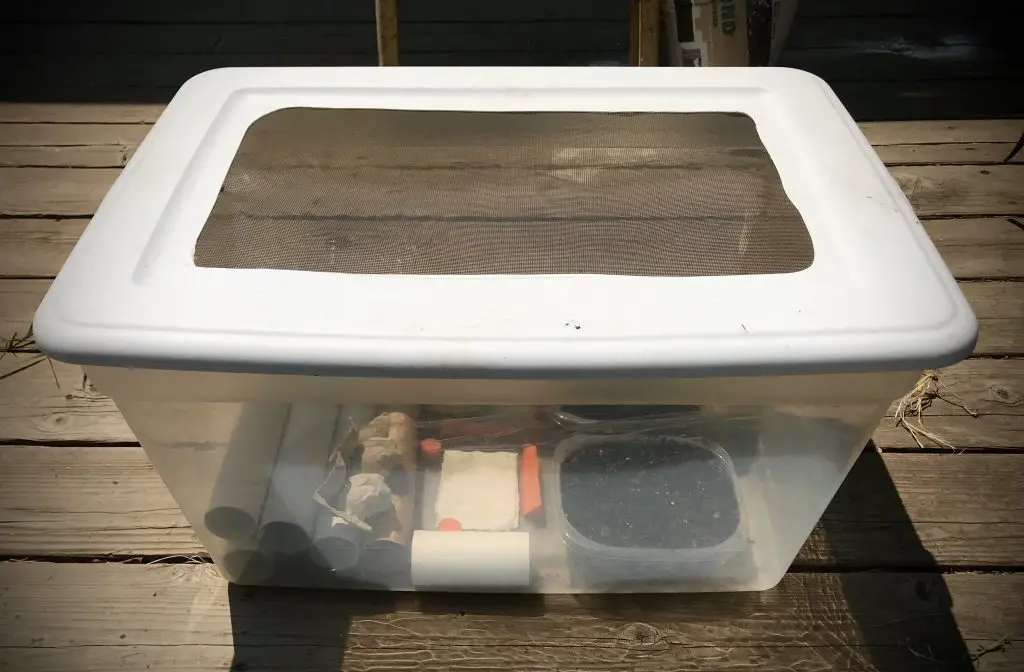
You can easily build your own cricket breeding farm at home. If you choose not too, you can find a Cricket Breeding Kit on Amazon for a pretty good price.
What supplies do you need to breed crickets?
- 2 deep storage tubs: 1 tub is for breeding the crickets and the second tub is for your pinhead (baby) crickets.
- Screen: Cut a section out of the storage lid and use a
- Hot Glue Gun: to glue the screen to the lid
- 2 Empty Plastic Containers: for breeding trays
- Potting Soil: Add potting soil to breeding trays for crickets to lay their eggs in.
- Packing Tape: to tape around upper perimeter of cricket enclosure to deter crickets from climbing out
- Wet Sponge or Paper Towel: to provide moisture for your crickets. Add water to this daily.
- Empty Egg Crates, TP Rolls, Paper Towel Rolls: for crickets to hide in
- Slices of Fruits, Vegetables, Grains, Dry Pet Food: Feed slices of potato, apple, oranges, carrots, lettuce, cucumber, chicken crumbles(non-medicated), fish feed, dry cat food, etc:
- Spray Bottle: Keep the breeding tray soil and sponge or paper towel evenly moist.
Step 3: Caring for Crickets
What do You Feed Crickets?
Crickets grow very rapidly from 1/16″, pinhead, to 1″ by 6 weeks. Pinhead crickets can eat the same food as adult crickets do. They thrive on both sliced fresh fruits and vegetables for both their nutritional content and moisture. They also need food high in protein, such as chick crumbles, dry cat food and fish flakes.
| FRUITS & VEGETABLES | PROTEIN SOURCE |
|---|---|
| APPLE SLICES | CHICK CRUMBLES |
| CARROT SLICES | DRY CAT FOOD |
| ORANGE SLICES | DRY DOG FOOD |
| POTATO SLICES | FISH FLAKES |
| GRAPE SLICES | ALFALFA |
| GRAPE SLICES | BABY RICE CEREAL |
| CUCUMBER SLICES | WHEAT GERM |
| BANANA SLICES | WHEAT BRAN |
| LEAFY GREENS | CORN MEAL |
| SQUASH SLICES | |
Step 4: Crickets Laying Eggs
Where do Crickets Lay Eggs?
Outdoors, crickets will lay their eggs in the soil or near the stems of plants. Cricket egg laying substrate should provide them with a soil that is good at holding moisture, such as peat moss or an organic soil. The idea is to keep the soil warm and moist, not soggy, until the eggs hatch in about 2 weeks.
What do Cricket Eggs Look Like?
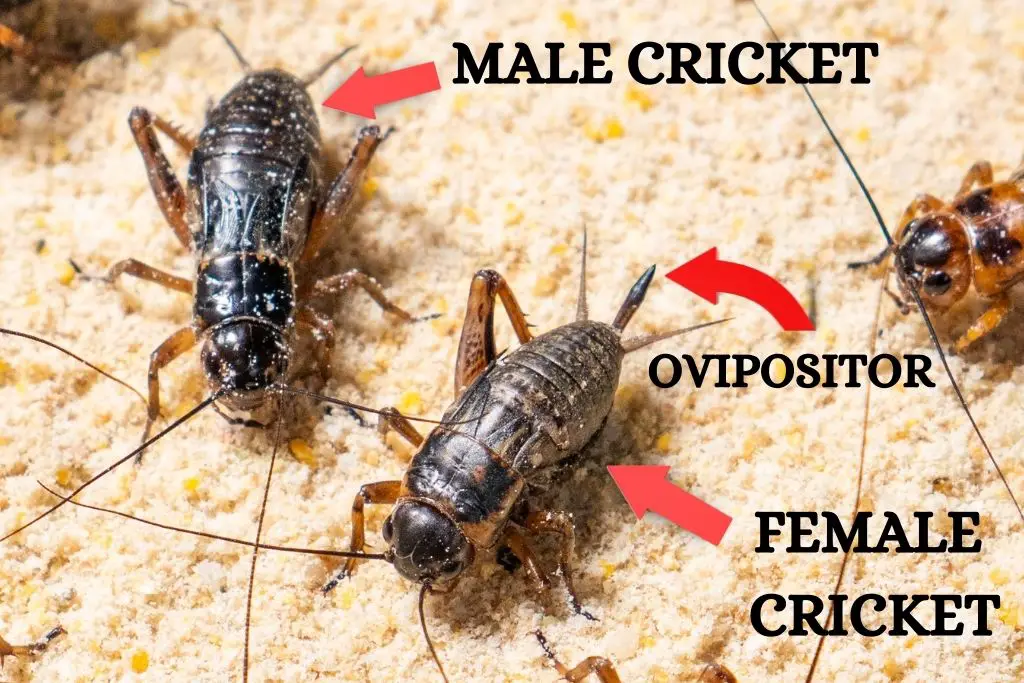
Cricket eggs look like tiny, off white grains of rice. They are about 1-2mm in length. The female cricket uses her ovipositor to deposit 5-10 eggs a day below the surface of the soil. If you are using a see through egg laying tray, you may be able to see them on the sides of the container.
How Many Eggs do Crickets Lay?
An adult female cricket can mate with several males and choose which sperm she wants to fertilize her eggs. She will lay 5-10 eggs that look like a grain of rice, but much smaller. (The average grain of rice is 7-9 mm and cricket eggs are only 1-2mm.) That comes to a total of about 100 tiny eggs throughout her short lifetime.
Step 5: How to Incubate Cricket Eggs
After giving your crickets 2 weeks to lay eggs in the substrate:
- Remove the laying trays.
- Spritz substrate once again with water. Don’t flood it. You don’t want to drown the eggs.
- Cover laying trays with plastic.
- Poke holes with a toothpick in the top of the plastic for ventilation.
- Place laying trays in a separate deep container, away from the adult crickets.
- Maintain 85-90℉.
- Tiny pinhead crickets should begin emerging within 9-10 days.
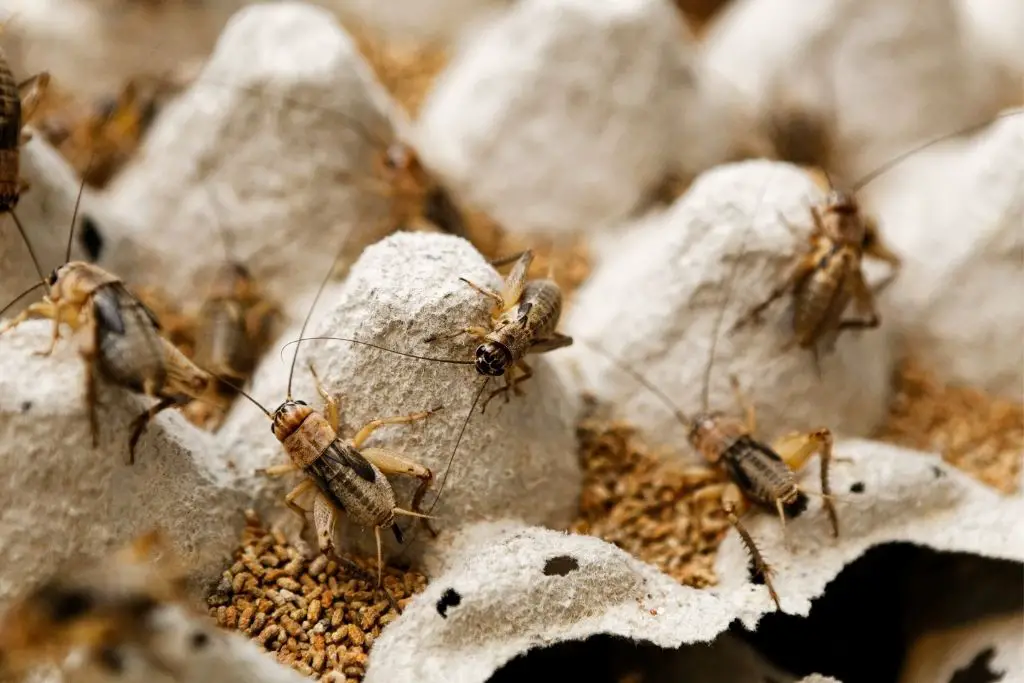
What Temperature do Cricket Eggs Incubate at?
Breeding crickets temperature should be kept at 70-75℉. Incubating cricket eggs should be kept at 85-90℉. It is recommended to maintain this temperature along with humidity 80% + for 10 days.
How do You Keep Cricket Eggs Warm?
Cricket eggs need to be kept at 85-90℉ with at least 80% humidity in order to incubate. If outdoor temperatures are not sufficient to maintain this temperature, an external heat source is necessary. Reptile lights or heating pads will work to maintain this temperature.
At slightly lower temperatures the eggs will still hatch, but will take a little longer.
Step 6: Cricket Eggs Hatching
How Long Does it Take for Cricket Eggs to Hatch?
If cricket eggs are incubating at 85-90℉ and 80% or higher humidity, pinhead crickets should begin hatching in about 10 days.
Step 7: Caring for Pinhead Crickets
Once the eggs hatch, you will have numerous tiny little specks that cover the entire floor or bottom of an egg crate.
- Pinhead crickets, like adult crickets require 70-75℉ temperature.
- Small crickets diet is the same as an adult cricket diet.
- Offer slices of fruits, vegetables and grains.
- Place a wet paper towel or sponge inside the tub for crickets to drink from.
- Offer protein in the form of chick crumbles, dried cat or dog food or fish flakes.
- Provide plenty of places for crickets to hide. Empty egg crates, toilet paper rolls or paper towel rolls work great!
- Be extra careful placing any food or wet paper towels down in the enclosure. Pinhead crickets can easily be squished! Gently blow where you want to place the food and place it down.
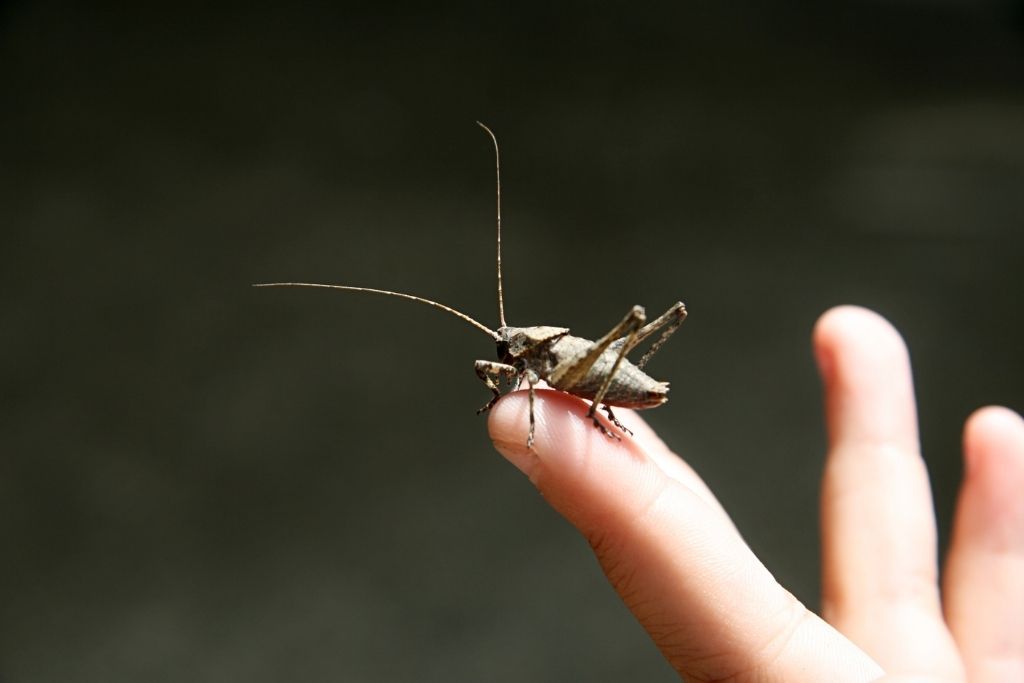
Step 8: Feeding Chickens Crickets
Now that you know how to raise crickets for chickens, why not give it a try? Crickets are very nutritious and a healthy treat to give your chickens on occasion.
They are high in protein and contain other vitamins and minerals that are beneficial for them. They are especially good to feed your molting chickens. They need the extra protein for growing in new feathers.
How many crickets can I feed my chicken?
An adult chicken can safely consume up to 10% of their daily diet in treats. So, if an adult chicken eats 1/2 cup of layers feed a day, she would be able to eat .8 TBS of treats a day. That is a little less than 1 TBS.
Don’t feed all of your crickets to your pet. Save enough so they can breed and produce more crickets to keep the cycle going!
Step 9: Using Cricket Frass in the Garden
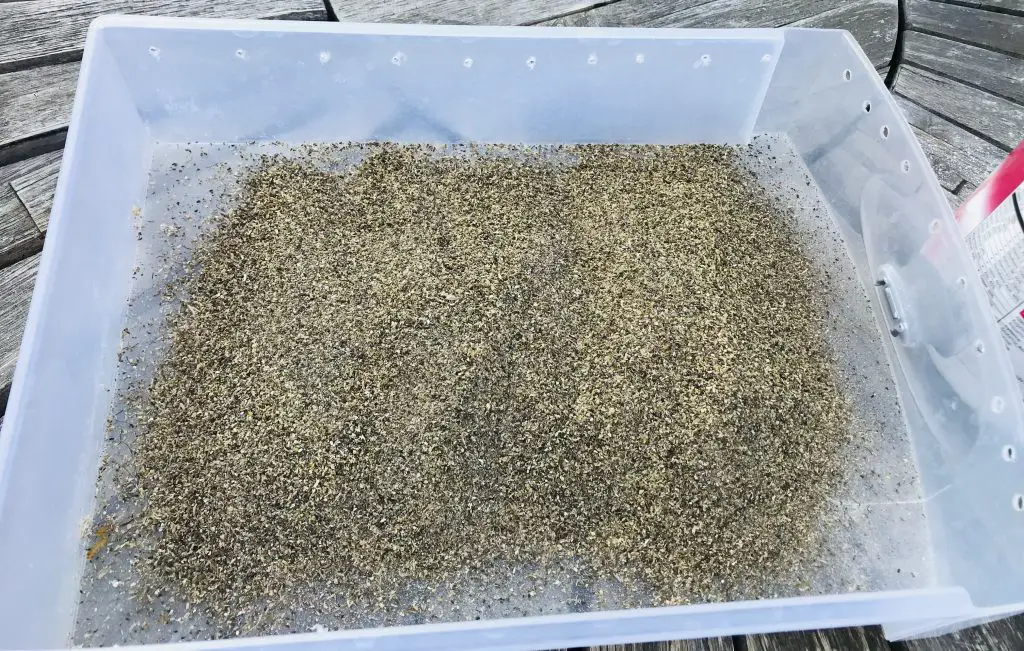
What is cricket Frass?
Cricket frass is the dry, sand like poop that accumulates on the bottom of your “cricket farm.” It contains a beneficial amount of the essential nutrients that a garden craves: nitrogen, phosphorus and potassium.
Don’t throw away the excrements or “frass” that is leftover from your cricket farm. Many people will pay good money for this stuff!
If you have a mealworm farm, save the castings and frass from this too. Your garden will thank you! If you are interested in starting your own mealworm farm, read my article How to Breed Mealworms at Home – Best Setup Guide. This will give you simple step by step instructions on how to do it.
How to Collect the Frass
The bottom of your cricket or mealworm container will be a mixture of feed, frass and exoskeletons. Use a sifter to separate your frass. Hold a container under your sifter and collect the frass. It is much finer and will sift right through.
How to Use Frass in Your Garden
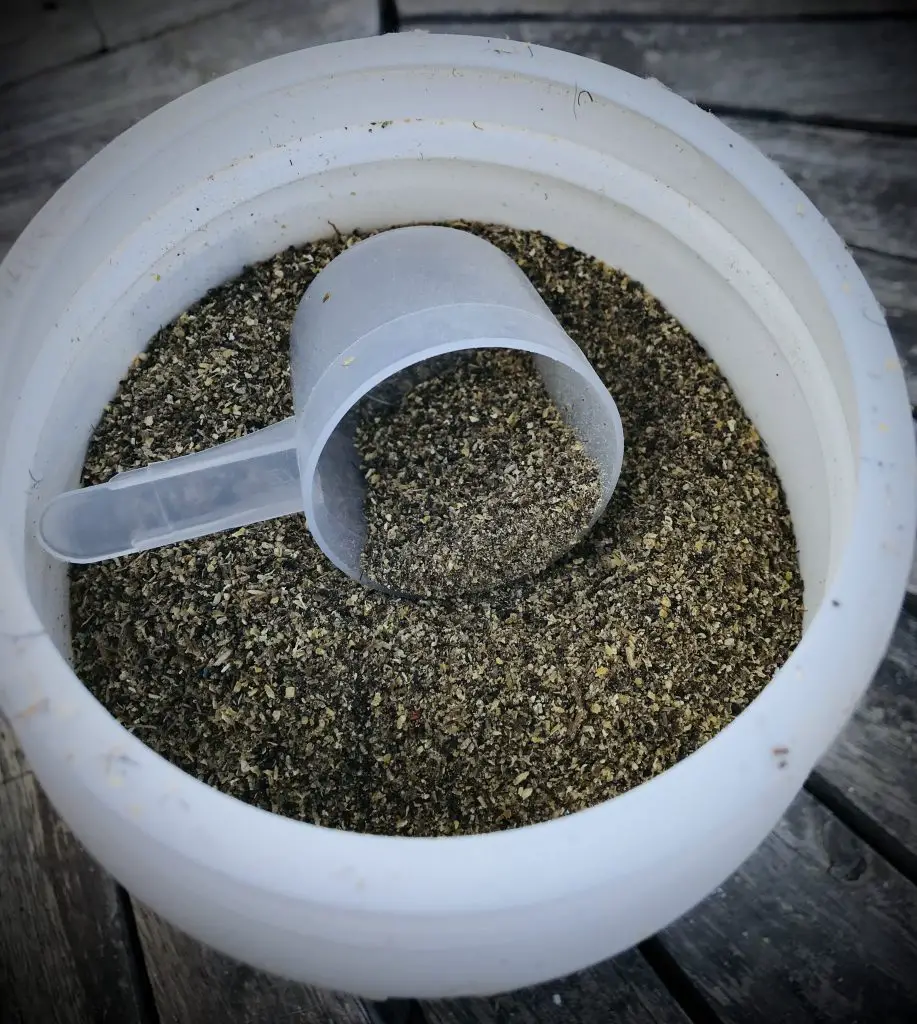
Add to Dechlorinated Water: By combining the dry frass with water, it becomes liquid gold for your garden. It is both a natural and a more economical way of fertilizing your garden.
- Combine 1 TBS frass for each gallon of water.
- Let is set out in the sun for several hours.
- Shake it up and use to water your garden.
Use as Soil Amendment:
- Break up the top few inches of soil around your plants
- Scatter frass around the garden soil.
- Give your garden a good, deep watering to let the frass get down to the roots.
Add to Potting Soil:
- Add 1 cup for each cubic foot of soil.
- Mix well.
- Add to pots.
- Sprinkle a little dry frass or liquid frass every few weeks to potted plant.
Conclusion: How to Breed Crickets at Home

Breeding crickets at home will not only save you a lot of money, but is a very nutritionally healthy treat for your pet chicken or reptile.
Starting and maintaining your own “cricket farm” is really quite simple to do. By following a few guidelines you can supply your chicken or reptile with never ending nutritional treats.
- Gather the essential “cricket farm” supplies.
- Maintain proper temperature and humidity.
- Provide daily recommended food and water.
Don’t throw away the excrements from your crickets. This is very valuable for your garden, providing nitrogen, phosphorus and potassium.
Remember not to feed all of your crickets to your pet, save some to continue the breeding cycle!
